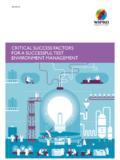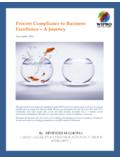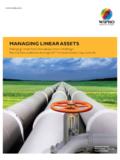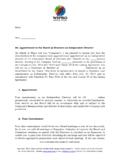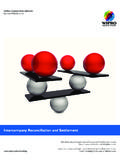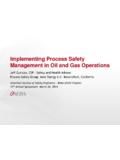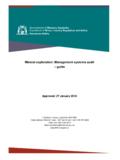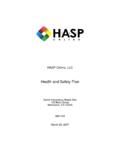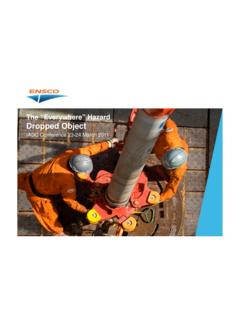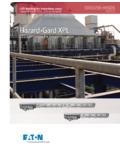Transcription of Safety and Health Management System in Oil and …
1 And Health Management System in Oil and gaS induStryneha ChauhanSAP EHS ConsultantTable of contents03 .. 1. Introduction03 .. 2. Industry Overview04 .. 3. Hazards related to Oil and Gas Industry04 .. Safety and Injury Hazards05 .. Health and Illnesses Hazards06 .. 4. Managing Occupational Safety and Health Risks06 .. Risk Management Process07 .. 5. Occupational Safety and Health Management System (OSHMS)07 .. Features of OSHMS08 .. Components of an effective OSHMS09 .. Benefits of OSHMS09 .. 6. Conclusion09 .. References10 .. About the Author10 .. About Wipro s Energy, Natural Resources, Utilities and Engineering & Construction (ENU) Strategic Business Unit10 .. About Wipro Introduction Safety and Health Management is one of the vital constituents of Oil and Gas industry activities because most of the operational conditions, chemicals and end products (hydrocarbons and other compounds) associated with Oil and Gas production are well-known to pose serious Safety and Health threats to the Industry Overview: UpsTreammIdsTream dOwnsTreamexploration and productionTransportation, storage and marketingrefining, sales and of Oil and Gas industryOn 25 August 2012, an explosion caused by the ignition of a leaking gas at the Amuay oil refinery, which is part of the Paraguana Refinery Complex, killed 48 people; primarily National Guard troops stationed at the plant, and injured 151 others1.
2 The Deepwater Horizon drilling rig explosion refers to the April 20, 2010 explosion and subsequent fire on the Deepwater Horizon semi-submersible Mobile Offshore Drilling Unit (MODU) killed 11 workers and injured 16 others2. The explosion caused the Deepwater Horizon to burn and sink, resulting in a massive offshore oil spill in the Gulf of Mexico, considered the largest accidental marine oil spill in the world, and the largest environmental disaster in to the report developed by the NORA Oil and Gas Extraction Council; In the US, during 2003-2008, 648 oil and gas extraction workers were fatally injured on the job, resulting in an occupational fatality rate of deaths per 100,000 workers eight times higher than the rate for all workers.
3 Nearly half of all fatal events in the Oil and Gas extraction industry resulted from highway crashes (29%) and workers struck by objects and equipment (20%)3. The above alarming incident data clearly emphasizes the need for an effective occupational Safety and Health Management System that integrates Safety and Health concerns into a daily routine. People working in Oil and Gas industry are exposed to various risk factors. Hence continuous monitoring of their working conditions and 3. Hazards related to Oil and Gas IndustryHazards in Oil and Gas industry can be divided into two broad categories: Safety and Injury Hazards Health and Illnesses Safety and Injury HazardsWorkers in Oil and Gas industry are generally susceptible to the following Safety and injury hazardswell-being is essential.
4 Health protocols and periodic medical checkup should be pre-defined and done for every worker depending on the job and work area type to identify possible deviations from the normal Health and to confirm that necessary counteractive actions are taken in advance. This paper outlines the key Safety and Health hazards associated with the upstream, midstream and downstream segments of Oil and Gas industry, including the significance, features, components and benefits of an effective Occupational Safety and Health Management System (OSHMS) for the and Injury Hazardspossible Causesmotor Vehicle accidentContact InjuriesFire and explosionsslips, Trips and FallsConfined space Often the roads leading to well sites lack firm shoulders and other Safety features4 Fatigue due to long driving distance and long working shifts Workers being struck by, entangled, or crushed by tools, machinery or other objects Presence of highly combustible hydrocarbons Presence of oxygen/ignition source Frequent need to work at elevations Uneven Surface Improper use or non-availability of fall protection systemsAccording to NIOSH, confined space refers to a space which by design has5.
5 Limited opening for entry and exit Unfavorable natural ventilation Not designed for continuous employee occupancyExamples of confined places in Oil and Gas industry are storage tanks, pipelines, silos, 2 Health and Illnesses HazardsKey processes Seismic Survey and evaluation Exploration and drilling Development and production Decommissioning Pipelines Transport and storage Marketing Product Refining Petro chemicals Sales and Distributionagents Pathogenic microorganisms Infection transmitting vectors Drilling mud Petroleum products (Hydrocarbons) Radioactive sources Chemicals and additives Metals (Pb, Cd, Mn, etc.) Extreme temperatures Silica/Asbestos Noise/Vibration Mechanical Ergonomic Psychosocial Petroleum products (Hydrocarbons) Dust from filing and scaling (from cleaning of pipes and tanks) Petroleum products (Hydrocarbons) Treatment chemicals Metals (Pb, Cd, Mn, etc.)
6 Silica/Asbestos Solvents Noise/Vibrationpossible Health effects Infectious and parasitic diseases ( , Hepatitis A, Cholera, Typhoid fever) Cumulative trauma disorders Chronic obstructive pulmonary disease Gastrointestinal disorders Dermal and eye issues Spinal disorders Neoplasms/Cancer Heat Stroke Stress Sleep deficits Noise induced hearing loss Drug and alcohol abuse Dermal and eye issues Pulmonary disorders Gastrointestinal disorders Neoplasms/Cancer Dermal and eye issues Gastrointestinal disorders Neoplasms/Cancer Noise induced hearing loss segmentsUpstreammidstreamdownstreamergon omic hazards (manual handling activities, repetitive motions, awkward postures); and psychosocial hazards (overwork, odd working hours, isolated sites, violence).The following table identifies the potential Health effects from key processes in Oil and Gas industry:Workers in Oil and Gas industry are generally susceptible to following agents which lead to various Health and Illnesses hazards: chemical hazards (toxic, corrosive, carcinogens, asphyxiates, irritant and sensitizing substances); physical hazards (noise, vibration, radiations, extreme temperature); biological hazards (virus, parasites, bacteria); 64.
7 Managing Occupational Safety and Health risk Management processAs stated earlier, risk Management is crucial for preventing work related injury and illness. It includes: Identifying the risks Evaluating and prioritizing the risks Implementing preventive/protective measures to control the riskThere are a number of circumstances in the Oil and Gas industry where a proper risk Management process is essential. For example:The aim of occupational Safety and Health risk Management is to identify and assess Safety and Health hazards existing at the workplace and to define appropriate control and retrieval processes in Oil and Gas industry are very complex. Hence it is essential that a systematized approach should be used for managing occupational Safety and Health hazards.
8 Its solution model can be based on the PDCA Cycle: Strategic HSSE Roadmap Work Flows Objectives and Targets Key Priorities Risk & Injury Management Health & Illness Management Training & Assessment Regulatory Compliance Monitoring Modeling Trends Performance Indicators Audits Management Review Actions for Continuous ImprovementsplandOCHeCKaCT Job Safety analysis: It is a process of systematically evaluating certain jobs, tasks, processes or procedures and eliminating or reducing the risks or hazards to As Low As Reasonably Practical (ALARP) in order to protect workers from injury or illness6 Workplace inspections and audits Change Management - identification of new hazards, introduction of new equipment/process, or regulatory needs7 Generally risk Management process in the Oil and Gas Industry Involves the Following Key steps: 5.
9 Occupational Safety and Health Management System (OsHms)plannInGrIsK IdenTIFICaTIOnrIsK assessmenTrIsK reCOrdInGrIsK COnTrOlFOllOw On assessmenTmOnITOr and reVIew Identify persons taking part in the risk Management process Gather Health and Safety information pertinent to Oil and Gas Industry Define strategy and workflows as per the business/legal requirements Evaluate the risk arising from each identified hazard Identify existing precautionary measures and what went wrong Determine what kind of injury or ill Health might occur Rank the risks on the basis of severity Define and Implement preventive measures to eliminate or minimize the risk of an incident/accident Identify possible Safety and Health hazards within workplace through work area inspections, previous accident/ ill- Health records, etc.
10 Record the findings of risk assessment for defining control measures, audit, internal review, regulatory purposes Ensure that implemented control measures are being used and are effective Reassess the efficiency of preventive/control measures Regular review and updating of risk assessment The insinuation of implementing an occupational Safety and Health Management System at all workplaces came into limelight, when Global Strategy on Occupational Safety and Health : Conclusions were adopted by the International Labour Conference at its 91st session, 2003. The Strategy advocates the application of a systems approach to the Management of national OSH systems7. Also, Guidelines on Occupational Safety and Health Management Systems (ILO-OSH 2001) provide national/organizational framework for occupational Safety and Health Management Systems8.


